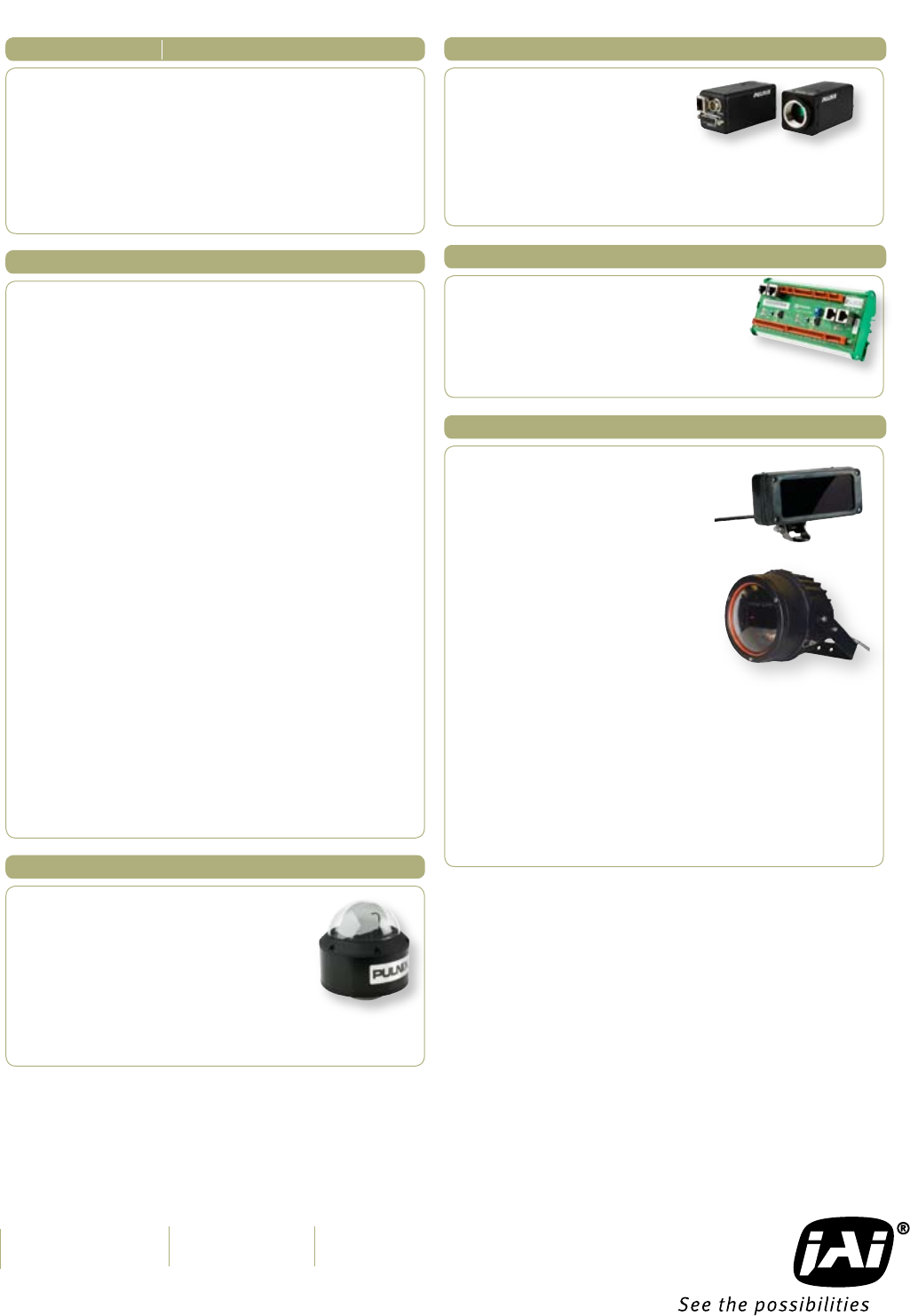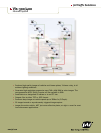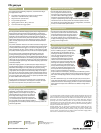
Visit our web site on www.jai.com
Company and product names mentioned in this datasheet are trademarks or registered trademarks of their respective owners.
JAI A·S cannot be held responsible for any technical or typographical errors and reserves the right to make changes to products and documentation without prior notication.
10221 Rev A.04.18.2007
Europe, Middle East & Africa
Phone +45 4457 8888
Fax +45 4491 8880
Asia Pacic
Phone +81 45 440 0154
Fax +81 45 440 0166
Americas
Phone (Toll-Free) 1 800 445 5444
Phone +1 408 383 0300
VIS-300/400
Components
VIS Trafc Camera (TS-9720 and TS-2030)
The JAI VIS includes the following components, customized according to
each application’s needs:
TS-9720EN, TSC-9720EN (color version), TS-2030 (available
2006) 2000 x 1000 HDTV format, traffic camera(s)
VIS300 Electronic Junction Panel
TLS-300 Traffic Light Sensor
Lighting options: TNF-21, TNF-31, TNC-1000
Laser vehicle detector trigger option
•
•
•
•
•
JAI is the world leader in high-performance vehicle imaging technologies that target the
specific needs and concerns of roadway operators and transit authority executives. JAI
delivers advanced real-world proven lane hardware and software that delivers superior
performance. We also offer products and services to reduce back-office enterprise
processing costs. No other industry provider can compete with our breadth of uniquely
tailored products such as high speed vehicle capture (0-200 MPH), license plate reading
(LPR) combined with vehicle fingerprinting, delivering patented video billing products,
and specific homeland security services.
Working together with our valued system integrator partners around the world, JAI
has delivered more that 20,000 vehicle imaging cameras and systems devoted to the
electronic tolling collection, speed enforcement, parking lot systems, and Homeland
Security markets. JAI manufactures core imaging cameras and vehicle imaging products
and services for worldwide traffic industry partners.
General Description
The next-generation JAI Vehicle Imaging System (VIS) is a high-performance
imaging solution for advanced ITS imaging applications, including auto-
mated license plate reading systems and vehicle ngerprinting recognition
applications. The VIS is eld-proven to produce high-contrast images of
passing vehicles and their license plates under all weather and lighting con-
ditions. Retro-reective and non-retro-reective license plates, even older
plates, are easily captured by the VIS in combination with JAI illumination
solutions, 24/7.
The JAI VIS is suitable for multi-lane use in either lane-based or high-speed
open-road applications. The VIS captures full-frame images on demand from
a variety of vehicle detection triggers. It can also be set to generate 30 full-
frame (768 pixels by 484 lines, or future release 2k x 1k) images per second.
This quality resolution (progressive scan) is critical to ensure plate legibility.
JAI can provide a variety of VIS nighttime lighting options to help your
system generate high-quality images at night. These options include
continuous lighting (TNC-1000), as well as nighttime ash lighting (TNF-21 or
TNF-31) that can accommodate the ever-widening range of plate color combi-
nations. We can even handle those situations in which near-infrared lighting
cannot produce legible plate images. All available VIS lighting options meet
road safety standards.
Unlike other imaging systems, the JAI VIS Subsystem adapts instantly to
changing lighting conditions, even when there is no vehicle in the camera’s
eld of view. This intelligence is made possible by a JAI patent-pending
Trafc Light Sensor that continuously measures the instantaneous dynamic
range of plate/vehicle brightness and electronically adapts camera param-
eters (such as gain and shutter speed) to achieve optimal imaging. Because
the camera uses no mechanically moving parts (i.e. auto-iris lens) are used,
it is much less likely to fail. Please refer to our separate specication sheets
for further details of the VIS components.
The light sensor and VIS cameras communicate over a local VIS network
utilizing Ethernet communications. VIS subsystems can report the health
and status of all components to any IP address on the network.
The VIS trafc camera utilizes a state-of
the- art progressive interline transfer CCD
that captures all of the vertical resolution at
once with no eld-to-eld imaging delays.
Progressive scanning allows the VIS camera
to capture a rapidly moving vehicle at high resolution without the need for a
mechanical shutter. VIS camera provides two resolution options for various
lane widths and comes complete with zoom lens, antiglare lter, and interface
circuitry in a heated weather-proof enclosure.
Smart Light Sensor (TLS-300)
The patent-pending JAI light sensor is the driver of the
VIS Network. It continuously monitors the ambient
lighting conditions, then computes shutter, gain, and
pedestal settings for the cameras on the network to
ensure high-contrast images. These commands are
then broadcast over the VIS Ethernet network every
1/10 second to keep the cameras up to date with even
the most rapidly varying ambient lighting conditions.
A single light sensor is commonly used to control up to twenty cameras for
multi-lane applications.
VIS Junction Panel (VJP300)
The VIS Junction Panel makes site installation quick
and easy. The Junction Panel is the interface between
the JAI VIS Subsystem and the rest of your system. It
is used with a DC output power supply (AC PSU) for
the cameras and light sensor, and terminal blocks to
simplify connecting trigger input, host interface and intercon-
necting cameras and light sensor.
Nighttime Illuminator(s) (TNF-21, TNF-31, TMC-1000, LED-12)
Three lighting options are available for the VIS
Subsystem. The TNF-21 or TNF-31 Trafc Night
Flash is an 18W long life (up to 4 million ashes)
dual-band ash unit. The ash lters light to
wavelengths invisible to the human eye, which
means it is well suited for both front and rear
vehicle imaging. The TNC-100 is a 70 watt
continuous white-light lamp and a focusing
reector enclosed in an outdoor xture. It il-
luminates up to one-and-a-half lane widths with
white light. The amplitude of the light can be set
to achieve a wide range of illumination levels.
A unique feature of this gas lamp is its ability to
produce very bright light that is stable over very
short exposure times, without brightness oscil-
lations. In contrast, the brightness of most gas
lamps oscillates at the AC frequency, which produces unsatisfactory pictures
at the high shutter speeds needed to freeze fast-moving vehicles. Because the
TNC-1000 is extremely bright, however, it is only suitable for rear imaging of
vehicles.
The LED-12 illumination ring is a 6 watt ultra long-life (>100,000 hours) low-in-
tensity white-light illuminator. It is incorporated into the camera housing and is
suitable for front or rear vehicle imaging. The LED-12 is used in those situations
where certain license plate color combinations are difcult to image with the
ash alone.
TNF-21
TNF-31




